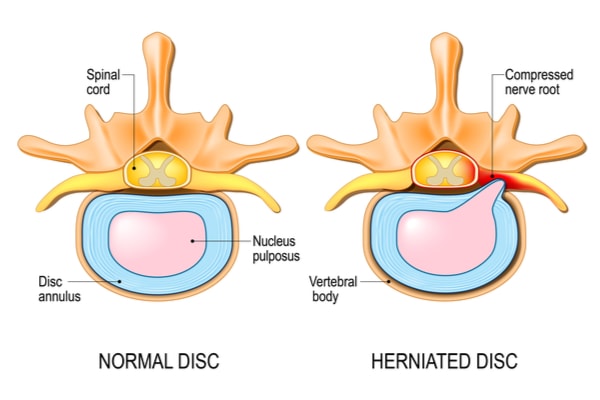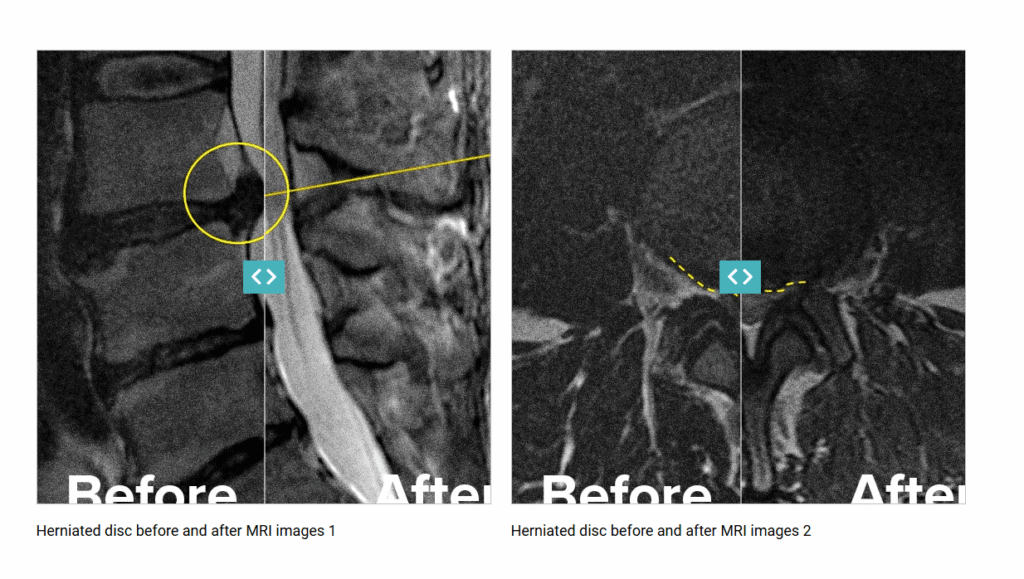Herniated Disc: What You Need To Know

Medically Reviewed By:
A herniated disc may interfere with daily routines, making simple tasks such as sitting, standing, or lifting more challenging. Discomfort may also spread into the arms or legs, impacting sleep and reducing physical activity over time. These changes can be frustrating and lead to decreased strength and a gradual loss of mobility.
Understanding how a herniated disc develops, the variations in symptoms, and the range of available treatment options is vital for managing this condition and can support improved mobility and function.
Spinal Disc Anatomy And Physiology
Spinal discs serve as natural shock absorbers between the vertebrae, allowing the spine to bend, twist, and support various physical activities. Each disc has two primary components: the annulus fibrosus and the nucleus pulposus.
The annulus fibrosus is the tough, fibrous outer layer consisting of concentric rings of connective tissue. This structure helps to stabilize the disc, contain the inner core, and resist twisting forces during movement.
At the center of the disc, the nucleus pulposus is a gel-like substance composed mainly of water and collagen. It helps distribute pressure evenly across the disc, providing essential cushioning during activities such as walking, bending, or lifting.
These two structures work together to maintain spinal alignment and absorb mechanical stress. Because spinal discs lack a direct blood supply, they rely on nutrient exchange through the adjacent vertebral endplates. Adequate hydration and nutrient flow are essential for maintaining disc health and function.
What Is A Herniated Disc?
A disc herniation occurs when the annulus fibrosus—the outer layer of a spinal disc—tears or weakens, allowing the soft inner core, known as the nucleus pulposus, to shift or protrude through the damaged area. This displaced material may place pressure on nearby spinal structures.
In many cases, the herniation compresses spinal nerve roots or the spinal cord. This can contribute to localized pain near the affected disc and may also result in symptoms like tingling, numbness, or muscle weakness that follow the path of the affected nerve. These radiating symptoms are known as radicular pain and can affect the arms or legs.

The illustration below highlights the difference between a healthy spinal disc and a herniated one.
In a healthy disc, the nucleus pulposus is securely contained within the annulus fibrosus, maintaining spinal alignment, flexibility, and support. In contrast, a herniated disc shows the gel-like center pushing through a tear, placing pressure on nearby neural structures.
Some individuals may refer to this condition as a “slipped” or “ruptured” disc. While these terms are common, they may not accurately describe the underlying changes. A herniated disc differs from a disc bulge or protrusion, in which the nucleus pulposus remains contained but pushes outward, which may create pressure without a complete tear.
Herniations can vary in size and location along the spine, which may influence the type and severity of symptoms. Understanding these structural changes is essential in guiding evaluation and determining appropriate treatment options.
Potential Causes Of Disc Problems
Several factors may contribute to disc damage, potentially leading to conditions such as herniation. These factors can act individually or accumulate over time:
- Age-related degeneration: As spinal discs age, they tend to lose water content and flexibility. This natural decline may increase the risk of tearing or displacement under pressure.
- Trauma or injury: A sudden impact, such as a fall, collision, or forceful blow, may cause a disc to tear or shift, sometimes resulting in pain and nerve irritation.
- Repetitive strain: Frequent bending, twisting, or lifting can place excess stress on the spine. Over time, this strain may weaken the disc structure and contribute to herniation.
- Improper lifting techniques: Lifting heavy objects without correct body mechanics can place additional force on the lower spine, raising the risk of disc injury.
- Prolonged sitting: Sitting for extended periods, especially with poor posture, compresses the lower spinal discs and may reduce circulation that supports disc health.
Who Is More Likely To Be Affected?
Some individuals may be more likely to experience a herniated disc due to lifestyle factors, genetics, or occupational demands that place added stress on the spine. These include:
- Older adults: With age, spinal discs naturally lose hydration and flexibility, meaning older adults may be more likely to suffer things like displacement or experience tears.
- Athletes: Repetitive or high-impact movements, such as bending, twisting, or lifting, can place added strain on spinal discs, increasing the risk of herniation.
- Smokers: Smoking may reduce oxygen supply to spinal tissues, which can impair disc maintenance and accelerate age-related changes.
- Individuals in physically demanding jobs: Occupations that involve frequent lifting, bending, or repetitive motion may increase cumulative stress on the spine.
- Those with a family history of spine issues: Genetic factors may influence disc strength and resilience, increasing the likelihood of disc-related conditions.
Common Symptoms Of A Herniated Disc
Symptoms of a herniated disc can vary based on the location and severity of the disc disruption, particularly if nearby nerves are affected. Common symptoms may include:
- Sharp or radiating pain: Pain may remain near the spine or travel into the arms or legs along the path of an irritated nerve.
- Muscle weakness: Compressed nerves may disrupt muscle function, leading to noticeable weakness in the arms, legs, or grip.
- Tingling, numbness, or burning sensations: Nerve irritation can cause unusual sensations in specific areas the affected nerve serves.
- Reduced reflexes: Reflexes in areas such as the knees or ankles may become diminished due to impaired nerve signaling.
Limited mobility: Stiffness, pain, or weakness may interfere with walking, lifting, or maintaining certain positions for extended periods. - Low back pain: Low back pain is a common symptom that can arise from various causes, including muscle strain, joint issues, or nerve irritation.
- Back Pain When Getting Up From A Chair: Pain when rising from a seated position may be due to muscle stiffness, joint degeneration, or spinal issues. It can cause discomfort in the lower back, often easing with movement but recurring with prolonged sitting. Read More About Back Pain When Getting Up From a Chair.
Why Early Diagnosis Matters For Disc-Related Health Issues
Recognizing early signs of disc problems and consulting a medical professional may help prevent worsening symptoms and support long-term spinal health. When issues like radiating pain, muscle weakness, or numbness begin to affect mobility or daily function, timely evaluation becomes especially important.
Delaying care may lead to increased nerve irritation or progressive muscle dysfunction. Early diagnosis enables physicians to pinpoint the source of symptoms and recommend suitable treatment options. To assess disc-related concerns, physicians may use the following diagnostic tools:
- Physical examination: Evaluates posture, range of motion, strength, reflexes, and areas of sensory change.
- Neurological assessment: Helps determine nerve involvement by testing sensation, reflexes, and motor control.
- Magnetic resonance imaging (MRI): Offers detailed views of spinal discs, nerve roots, and surrounding soft tissues.
- Computed tomography (CT) scan: Produces cross-sectional spine images to identify structural changes or disc displacement.
- X-rays: Used to evaluate spinal alignment or detect fractures, though discs themselves are not visible.
- Electrodiagnostic testing: Tests such as electromyography (EMG) or nerve conduction studies assess nerve and muscle function.
Treatment Options For Herniated Discs
Treatment for a herniated disc typically begins with conservative strategies aimed at reducing discomfort, managing inflammation, and supporting mobility.
- Activity modifications: Avoiding certain movements that worsen symptoms may help reduce pressure on the affected disc, allowing for improved recovery.
- Warm or cold compresses: Applying heat or cold may help relax muscles, decrease localized inflammation, and provide temporary symptom relief.
- Physical therapy: Guided exercises and movement strategies may improve flexibility, strengthen supporting muscles, and promote spinal alignment.
- Acupuncture: This approach may assist with pain management by stimulating nerves and soft tissues through the use of fine needles.
Can A Disc Problem Heal Without Surgery?
Many herniated discs improve over time without surgical intervention. In numerous cases, symptoms gradually decrease over several weeks or months as inflammation subsides and disc material is reabsorbed naturally. Remaining active, while avoiding movements that aggravate symptoms, can support this recovery process.
However, some individuals may continue to experience persistent or more severe symptoms that limit daily function. In such cases, physicians may recommend additional interventions to help reduce discomfort and improve mobility.
Procedures using Regenexx lab processes offer a non-surgical option for addressing disc-related pain. These image-guided procedures use the body’s own healing agents, including platelet-rich plasma (PRP) treatments or bone marrow concentrate (BMC) prepared as Regenexx SCP or SD injectates by physicians in the licensed Regenexx network.
These procedures are designed to reduce inflammation, support the body’s natural healing process, and promote improved function, offering an alternative to surgery with less downtime and reduced reliance on prescription medications such as opioids.
Procedures Using the Regenexx Approach for Herniated Disc Symptoms
Physicians in the licensed Regenexx network offer procedures that provide a non-surgical option for addressing disc-related symptoms. During these outpatient procedures, physicians use advanced, image-guided techniques to deliver customized concentrations of the individual’s own healing agents directly to areas of disc injury.
These procedures may use either super-concentrated PRP treatments prepared from the individual’s own blood or BMC processed as Regenexx SD injectate, depending on the nature of the disc condition determined by the treating physician.
For certain disc-related issues, treatment may involve the Regenexx PL-Disc injectate. This approach uses Regenexx PL injectate (Spine), a specialized formulation derived from PRP that contains concentrated growth factors while minimizing inflammatory components.
Watch a spinal procedure performed by a physician in the licensed Regenexx network.
The goal is for physicians to use procedures that are as targeted and minimally invasive as appropriate for the condition. The physician will determine whether a platelet-based or BMC procedure may offer the best opportunity for improved function and reduced symptoms.
MRI Images Following The Regenexx PL-Disc Injectate for a Herniated Disc
The MRI images below show before-and-after views of an individual treated with the Regenexx PL-Disc injectate for a subligamentous disc herniation. Following the procedure, the individual reported that it helped reduce their discomfort and supported their return to regular activities within several weeks.
*Individual outcomes may vary. For more information about patient outcomes, please visit our Patients’ Results page.
Scroll down to view the MRI taken before the procedure using the Regenexx PL-Disc injectate. The white or lighter area highlights the herniated disc material. Scroll to the left to view the follow-up MRI captured two years later, which shows structural changes at the treatment site.

Explore Non-Surgical Options That May Help With Disc-Related Symptoms
Herniated discs may limit movement, reduce activity levels, and interfere with everyday routines. While many cases improve with time and conservative care, some situations may benefit from targeted intervention to help reduce symptoms and support the body’s natural healing process.
Procedures using Regenexx lab processes provide non-surgical, image-guided treatment options that use the body’s own biologic materials to address disc-related issues. These customized procedures may help minimize downtime and offer an alternative to surgery for individuals seeking to improve mobility and resume the activities that matter most.
If disc-related symptoms persist or worsen, an early evaluation may help identify the most appropriate next steps. Physicians in the licensed Regenexx network use advanced diagnostics and precise techniques to develop care plans customized to the specific needs of the spine.
See If Regenexx Is Right For You
To speak with one of our team members about how the Regenexx approach may be able to help your herniated disc pain or injury, please complete the form below and we will be in touch with you by the next business day.

Medically Reviewed By:
